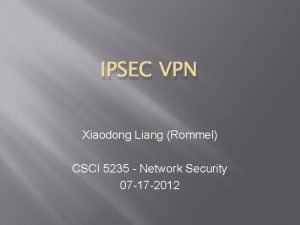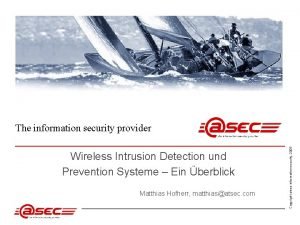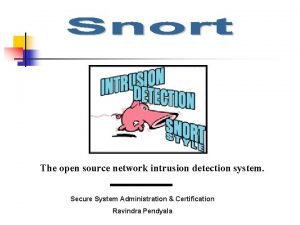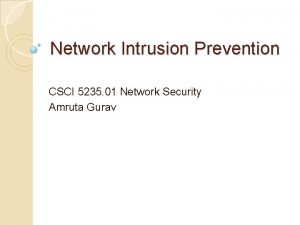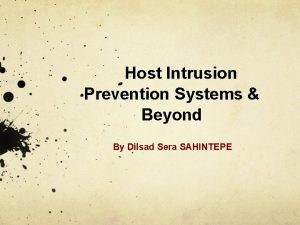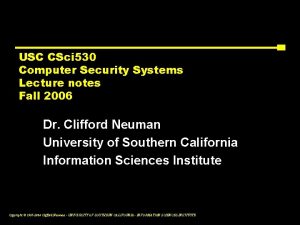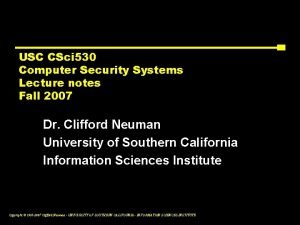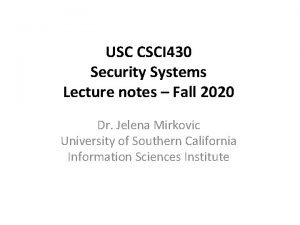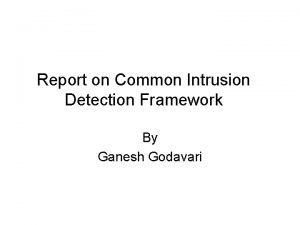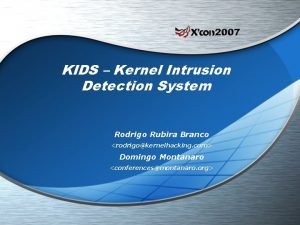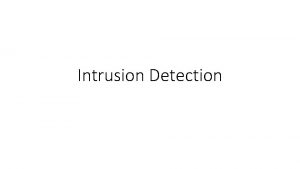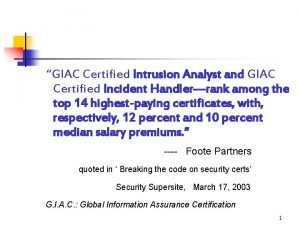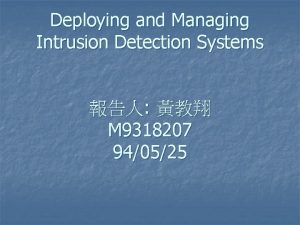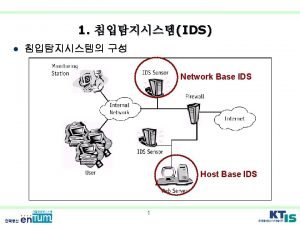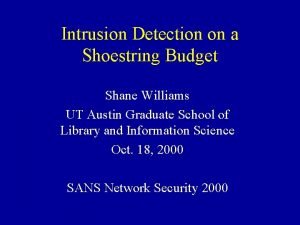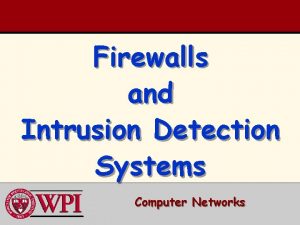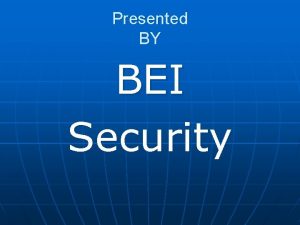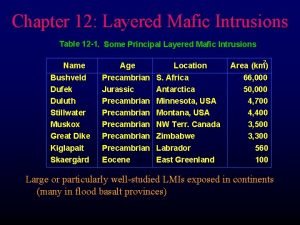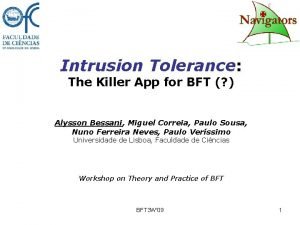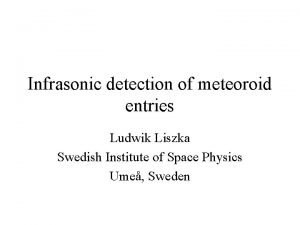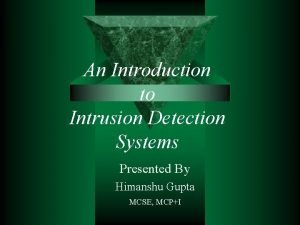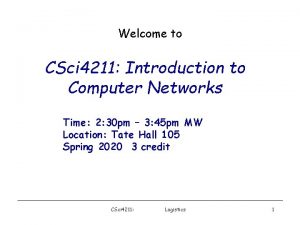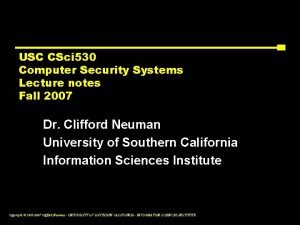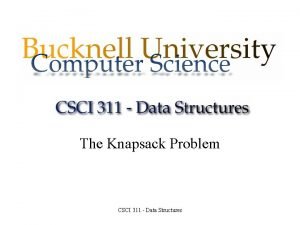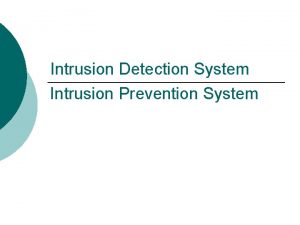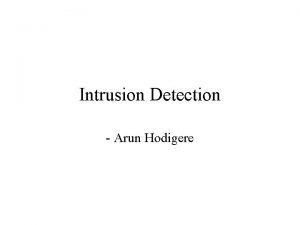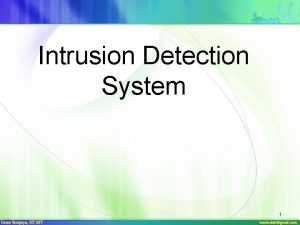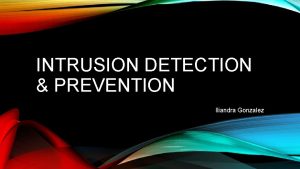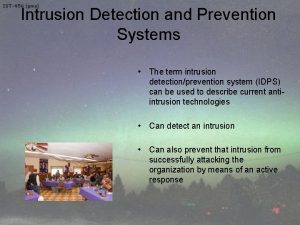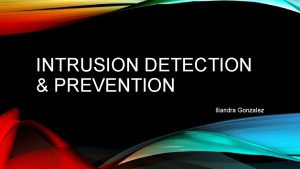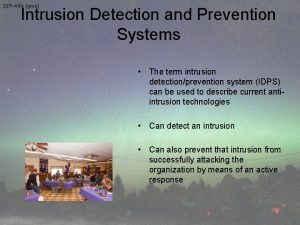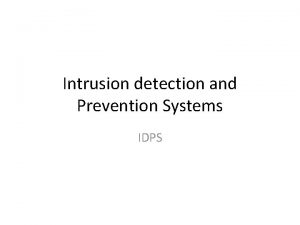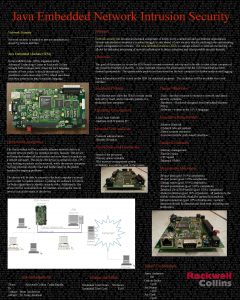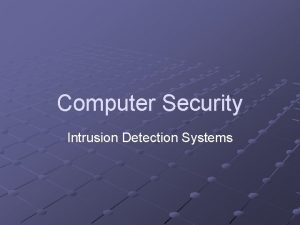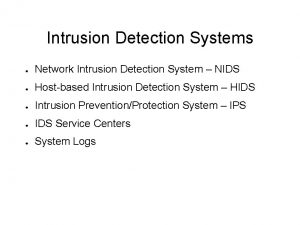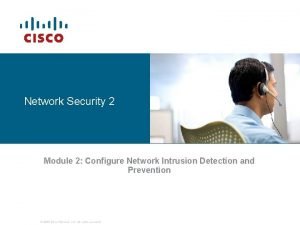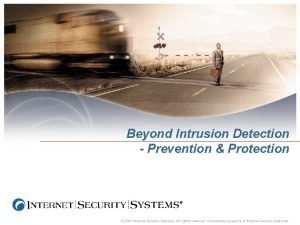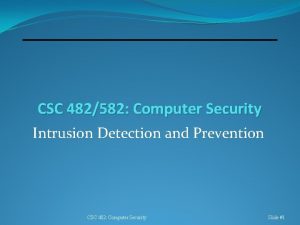Network Intrusion Prevention CSCI 5235 01 Network Security










































- Slides: 42

Network Intrusion Prevention CSCI 5235. 01 Network Security Amruta Gurav

Outline �Intrusion System Terminologies �Network Intrusion Prevention Overview �Cisco IOS IPS �Cisco IPS Sensor Software �IPS High Availability

Need for intrusion prevention system � Today, viruses, worms, and several other invading malicious codes and programs proliferate widely on the Internet. With the environment becoming increasingly hostile, networks are easy targets because the infection can spread across the network rapidly. � Networks need to be designed and equipped with sophisticated intelligence to diagnose and mitigate threats in real-time.

Intrusion System Terminologies � IDS (Intrusion Detection System): The term IDS is typically limited to sensors that employ promiscuous-only monitoring based on an out-ofpacket stream. � IPS (Intrusion Prevention System): The term IPS is most commonly applied to sensors that reside inline within the packet stream and that can drop malicious packets, flows, or attackers. � IPS Feature versus IDS Feature: The IPS feature is specifically the inline monitoring with inline response action deny-packet capability, whereas the IDS feature is promiscuous-only monitoring with post attack response actions such as TCP reset or block/shun on an external device.

Network Intrusion Prevention Overview � Networks today have grown both in size and complexity while the environment has remained highly exposed and vulnerable. � Because of the evolving network landscape, networks require a security solution that works throughout the network in collaboration with all the network devices, servers, and endpoints within the network.

Challenges for networks in providing in-depth defense � Security incidents and evolving threats are on the rise and are increasing exponentially. � The complexity and sophistication of malicious codes and network exploits continues to rise. � The potential impact resulting from these attacks is significant. � Multiple technologies are working together, in contrast to the point products deployed independently in the past.

Cisco Network Intrusion Prevention solution � It is an integral part of the Cisco Self-Defending Network strategy that provides network intelligence to identify and prevent malicious traffic including network viruses, worms, spyware, adware, and application abuse. � The solution offers comprehensive threat prevention and protection for a wide range of network intrusions and attacks.

Cisco IOS IPS � The Cisco IOS Intrusion Prevention System (IPS) feature set provides an integrated inline deep-packet inspection solution within the router software architecture. � IOS IPS enables the network to be able to defend itself with the intelligence to monitor, detect, identify, classify, and mitigate malicious traffic in real-time and stop malicious traffic close to its entry point.

Key features in IOS IPS � Protects against network viruses, worms, and a large variety of network threats and exploits. � Eliminates the need for a standalone IPS device. � Provides integrated inline deep-packet inspection. � Supports about 2, 000 attack signatures similar to those available on a regular Cisco IPS sensor appliance. � Uses Cisco IOS routing capabilities to deliver integrated functionality. � Enables distributed network wide threat mitigation. � Sends a syslog message or an alarm in Secure Device Event Exchange (SDEE) format upon detecting an attack signature. � Complements Cisco IOS Firewall and VPN solutions for superior threat protection at all entry

Deploying IPS Figure: Cisco IDS/IPS Network wide Deployment

Cisco IPS Sensor OS Software � Cisco IPS Sensor software version 6. 0 is a comprehensive, end-to-end protection solution for network-based sensors that delivers the latest IPS capabilities, enhanced performance, security improvements, and a range of new enhanced features. � Cisco IPS Sensor Software supports both the IDS and IPS capabilities for hybrid operation, acting simultaneously as an IDS sensor and an IPS sensor.

Cisco IPS Sensor Software Figure 20 -6. Cisco IPS Sensor Software System Design

Components of Cisco IPS Sensor Software �Main. App �Event Store �Sensor. App (Analysis Engine) �Command Line Interface (CLI)

Main. App �Notification. App �Authentication. App �Attack Response Controller (ARC) �Interface. App �Log. App �Web Server �ctl. Trans. Source (Control Transaction server)

Sensor Software— Communication Protocols �IDAPI �RDEP 2 �IDIOM �IDCONF �SDEE �CIDEE

Sensor Software—User Roles �Administrator �Operator �Viewer �Service

Sensor Software—Partitions �Application partition �Maintenance partition �Recovery partition

Sensor Software—Signatures and Signature Engines � Signature: A signature is a description of a network traffic pattern that attackers use while conducting network-based attacks. � Signature Engine: A signature engine is a component of the Cisco IPS that is designed to support many signatures in a certain category. � The signature engines are designed to perform a wide range of functions, such as pattern matching, stateful pattern matching, protocol decoding, deeppacket inspection, and other heuristic methods.

Sensor Software—IPS Events � Types of IPS data that are communicated by various functional units: Intrusion events Error events Status events Control transaction log events Attack response events Debug events Control transaction events

Types of IPS events �ev. Alert �ev. Status �ev. Error �ev. Log. Transaction �ev. Shun. Rqst

Sensor Software—IPS Risk Rating (RR) � RR allows users to make informed decisions on the IPS inline drop actions and provides users with greater confidence by enhancing the reliability of the inline deployment. � RR is a multidimensional formula that is applied on a per-signature basis. RR has a value between 0 and 100; the higher the RR value, the greater the confidence that the event detected is an indication of malicious activity.

Risk Rating Calculation �Signature Fidelity Rating (SFR) �Attack Severity rating (ASR) �Target Value Rating (TVR) �Attack Relevancy Rating (ARR) �Promiscuous Delta (PD) �Watch List Rating (WLR) RR = ((ASR*TVR*SFR)/10000)+ARRPD+WLR

Sensor Software—IPS Interfaces �Command control interface �Sensing interface (aka Sniffing interface)

Sensor Software—IPS Interface Modes �Promiscuous mode �Inline interface mode �Inline VLAN pair mode �VLAN Group mode

Promiscuous mode Figure: Cisco IDS Sensor in Promiscuous Mode

Inline interface mode Figure: Cisco IPS Sensor in Inline Interface Mode

Inline VLAN pair mode Figure: Cisco IPS Sensor in Inline VLAN Pair Mode

VLAN Group mode � In VLAN Group mode, each physical interface or inline interface can be divided into VLAN group subinterfaces, each of which consists of a group of VLANs on that particular interface. With the introduction of multiple virtual sensors, the sensor can monitor one or more of these interfaces. � VLAN Group mode provides the capability of applying multiple policies to the same sensor. This allows the sensor to emulate multiple interfaces; with only a few interfaces, the sensor can seem to have many interfaces.

Sensor Software—IPS Blocking (Shun) � Host block: Blocks all traffic from a given IP address. � Connection block: Blocks all traffic from a specific source IP address to a given destination IP address and destination port. � Network block: Blocks all traffic from a given network subnet.

Sensor Software—IPS Rate Limiting �It provides the capability of reducing the effect of a denial of service (Do. S) attack or network attack, instead of blocking it entirely.

Sensor Software—IPS Virtualization � Virtual sensors can be effectively used to monitor multiple data streams, apply different configurations to different sets of traffic, monitor two network segments with overlapping IP spaces with one sensor, or monitor concurrently both the inside and outside of a firewall with one sensor. � Multiple virtual sensors can be hosted on the same appliance, each configured with different signature behavior and traffic feeds. � Each virtual sensor is associated with a specifically named signature definition, event action rules, and anomaly detection configuration. � The sensor can receive data inputs from one or many monitored data streams.

Sensor Software—IPS Security Policies �Signature definition policy �Event action rules policy �Anomaly detection policy

Sensor Software—IPS Anomaly Detection (AD) � The AD solution detects worm-infected hosts and worm-based attacks. � AD detects the following two situations: o The network starts to become congested by worm traffic. o A single worm-infected source enters the network and starts scanning for other vulnerable hosts.

Zones in IPS AD �Internal zone �Illegal zone �External zone

Modes in AD �Learn mode �Detect mode �Inactive mode

IPS High Availability � High availability is defined as building into the network the capability of the network to cope with the loss of a component while preserving network functionality. � There are three possible solutions to resolve situations in which the inline IPS device may fail: o Fail- open mechanism o Failover mechanism o Load- balancing mechanism

Fail- open mechanism �Hardware-based fail-open mechanism �Software-based fail-open mechanism

Failover mechanism �Layer 3: PIX/ASA Failover, Cisco IOS HSRP �Layer 2: Spanning Tree

Load-Balancing Technique �Cisco IPS sensors can be deployed inline as part of an Ether. Channel (EC) to provide redundancy.

Summary � Networks today are becoming increasingly vulnerable to hostile attacks and infections such as viruses and worms that spread rapidly, crippling the entire network. With this growing threat, networks need to be designed and equipped with the sophisticated intelligence to diagnose and mitigate these threats in real-time. � The chapter examined the core concepts for the Cisco IPS Sensor OS Software, such as the sensor system architecture, sensor communication protocols, signature and signature engines, IPS events and event actions, IPS Virtualization, and load-balancing techniques.

References � Bhaji, Yusuf. CCIE Professional Development Series Network Security Technologies and Solutions. 2008. � Information on trunk port- http: //www. cisco. com/en/US/docs/switches/datacenter/n exus 5000/sw/configuration/guide/cli/Access. Trunk. pdf � Signature engine- http: //www. cisco. com/en/US/docs/security/ips/5. 1/config uration/guide/idm/dm. Sg. Eng. html#wp 1044249 � Sensor software- http: //www. cisco. com/en/US/docs/security/ips/5. 1/config uration/guide/idm/dm. Arch. html

Thank you!!!!
 Primary prevention secondary prevention tertiary prevention
Primary prevention secondary prevention tertiary prevention Ike creates sas for
Ike creates sas for Datenkorrelation
Datenkorrelation Open source nids
Open source nids Configure ios intrusion prevention system (ips) using cli
Configure ios intrusion prevention system (ips) using cli Ips intrusion
Ips intrusion Csci 530
Csci 530 Netcheque
Netcheque Csci 430 usc
Csci 430 usc Privat security
Privat security The osi security architecture
The osi security architecture Guide to network security
Guide to network security Wireless security in cryptography
Wireless security in cryptography Electronic mail security in network security
Electronic mail security in network security Security guide to network security fundamentals
Security guide to network security fundamentals Security guide to network security fundamentals
Security guide to network security fundamentals Loss prevention and security in hotels
Loss prevention and security in hotels Common intrusion detection framework
Common intrusion detection framework Temaline dw
Temaline dw What is intrusion
What is intrusion Anestesia papilar
Anestesia papilar Magmatic intrusion
Magmatic intrusion Giac intrusion analyst
Giac intrusion analyst Immersive fantasy
Immersive fantasy Intrusion.win.iis.unicode.a.exploit
Intrusion.win.iis.unicode.a.exploit Law of superposition rock layers
Law of superposition rock layers Intrusion detection systems (ids)
Intrusion detection systems (ids) Intrusion budget
Intrusion budget Ids sensors
Ids sensors Bro intrusion detection
Bro intrusion detection Authorial intrusion definition
Authorial intrusion definition Fiber perimeter intrusion detection systems
Fiber perimeter intrusion detection systems Intrusion movie
Intrusion movie Intrusion movie
Intrusion movie Layered mafic intrusion
Layered mafic intrusion Intrusion
Intrusion Detecting golden ticket attack
Detecting golden ticket attack Intrusion tolerance
Intrusion tolerance Infrasonic intrusion detection
Infrasonic intrusion detection Analysis console for intrusion databases
Analysis console for intrusion databases Csci 4211
Csci 4211 Csci 530
Csci 530 Csci 311
Csci 311

